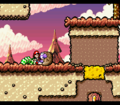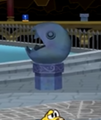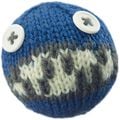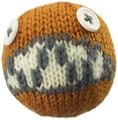Chomp Rock: Difference between revisions
(→Super Mario World 2: Yoshi's Island: link soft rock) |
No edit summary |
||
| (4 intermediate revisions by 4 users not shown) | |||
| Line 6: | Line 6: | ||
}} | }} | ||
{{Quote|Don't forget—you can run over baddies with a Chomp Rock. Good things might happen!|Message Block|Yoshi's New Island}} | {{Quote|Don't forget—you can run over baddies with a Chomp Rock. Good things might happen!|Message Block|Yoshi's New Island}} | ||
'''Chomp Rocks''', also known as '''Romp Chomps''',<ref>Black, Fletcher | '''Chomp Rocks''', also known as '''Romp Chomps''',<ref>{{cite|author=Black, Fletcher|date=2006|title=''Yoshi's Island DS'' Prima Official Game Guide|publisher=[[Prima Games]]|isbn=0-7615-5576-6|page=16}}</ref> are round stones that look like [[Chain Chomp]] heads. They appear primarily in the ''[[Yoshi's Island (series)|Yoshi's Island]]'' series. | ||
==History== | ==History== | ||
===''Yoshi's Island'' series=== | ===''Yoshi's Island'' series=== | ||
Chomp Rocks are common objects appearing in ''[[Super Mario World 2: Yoshi's Island]]'' and [[Yoshi's Island: Super Mario Advance 3|its Game Boy Advance versions]]. Chomp Rocks appear in gray and brown varieties, and the only difference is that gray ones will respawn at their starting point if the player goes offscreen and then returns, while the brown ones will not. Chomp Rocks are generally used for moving through [[soft rock]] and reaching high areas, but in some levels, they are an obstacle, such as when they need to be rolled off a thin pillar to reach a key. Some [[Slugger]]s hit these back and forth. [[Yoshi]] can push Chomp Rocks forward or jump on top of them to roll them in any direction. He can use Chomp Rocks to crush most enemies, including [[Tap-Tap]]. [[The Cave Of Chomp Rock]] is themed after them. | |||
Chomp Rocks | Chomp Rocks return in both sequels, ''[[Yoshi's Island DS]]'' and ''[[Yoshi's New Island]]''. Though they are mostly the same as before, Chomp Rocks differ in ''Yoshi's Island DS'' in that neither color respawns, except for a brown one in the [[Island Museum]]'s Land Enemy section. Chomp Rocks in ''Yoshi's New Island'' use the same model as [[snowball]]s, except the latter is retextured.<ref>[[:File:YNI Snowball Retextured Chomp Rock.png|Image showcasing the retextured Chomp Rock.]]</ref> | ||
Chomp Rocks | |||
===''Club Nintendo''=== | ===''Club Nintendo''=== | ||
| Line 29: | Line 22: | ||
====''Paper Mario: The Thousand-Year Door''==== | ====''Paper Mario: The Thousand-Year Door''==== | ||
Two Chomp Rocks appear in ''[[Paper Mario: The Thousand-Year Door]]'' in the [[Palace of Shadow | Two Chomp Rocks appear in ''[[Paper Mario: The Thousand-Year Door]]'' in the [[Palace of Shadow Tower]] area, blocking the [[Warp Pipe|pipes]] that Mario needs to unlock the tower. Actual Chain-Chomps guard the pipes. In this incarnation, the rocks are hollow and have open mouths. Mario can destroy the rocks by throwing [[Admiral Bobbery]] into the gaping maws of the rocks. When Bobbery explodes, the rock is destroyed. | ||
===''Mario & Luigi: Partners in Time''=== | ===''Mario & Luigi: Partners in Time''=== | ||
Brown Chomp Rocks | Brown Chomp Rocks appear in ''[[Mario & Luigi: Partners in Time]]'', where the Yoshis are needed to move them on two occasions to open up new paths in [[Yoob's Belly]]. Five Yoshis can also use a Chomp Rock to lower [[Sunnycide]]'s defense after the Bros. free them from Yoob eggs. | ||
===''Yoshi's Woolly World''=== | ===''Yoshi's Woolly World''=== | ||
Chomp Rocks reappear in ''[[Yoshi's Woolly World]]'', | Chomp Rocks reappear in ''[[Yoshi's Woolly World]]'', functioning identically as in the ''Yoshi's Island'', though designed after [[wikipedia:amigurumi|amigurumi]] crochet spheres that come in many different color variations with white buttons for eyes. [[Frame Chomp]]s can be turned into a Chomp Rock if Yoshi throws a yarn ball at one. The color of the Chomp Rock is determined by the color of yarn used. | ||
==Gallery== | ==Gallery== | ||
| Line 64: | Line 57: | ||
==Names in other languages== | ==Names in other languages== | ||
{{foreign names | {{foreign names | ||
|Jap=ワンワン{{hover|岩|いわ}}<ref>「スーパーマリオアドバンス3任天堂公式ガイドブック」 (''Super Mario Advance 3 Nintendo Kōshiki Guidebook'') | |Jap=ワンワン{{hover|岩|いわ}}<ref>{{cite|date=2002|title=「スーパーマリオアドバンス3任天堂公式ガイドブック」 (''Super Mario Advance 3 Nintendo Kōshiki Guidebook'')|publisher=[[Shogakukan]]|language=ja|isbn=978-4091060716|page=9}}</ref> | ||
|JapR=Wanwan Iwa | |JapR=Wanwan Iwa | ||
|JapM=Chain Chomp Rock | |JapM=Chain Chomp Rock | ||
|Chi=汪汪石 | |||
|ChiR=Wāngwāng Shí | |||
|ChiM=Chain Chomp Rock | |||
|Dut=Chomp-steen | |||
|DutM=Chomp Rock | |||
|FreA=Roc Boulouf | |||
|FreAM=Chomp Rock | |||
|FreE=Broie tout | |||
|FreEM=Crush everything | |||
|Ger=Big Chomp | |Ger=Big Chomp | ||
|GerM=Big Chomp | |GerM=Big Chomp | ||
|Ita=Masso tritatutto | |Ita=Masso tritatutto | ||
|ItaM=Grinder Rock | |ItaM=Grinder Rock | ||
|Kor=멍멍이돌 | |Kor=멍멍이돌 | ||
|KorR=Meongmeong'i Dol | |KorR=Meongmeong'i Dol | ||
|KorM=Chain Chomp Rock | |KorM=Chain Chomp Rock | ||
| | |Por=Pedra Dentada | ||
| | |PorM=From ''pedra'' ("stone") and ''Corrente Dentada'' ("Chain Chomp") | ||
|Rus=Кусалковалун | |Rus=Кусалковалун | ||
|RusR=Kusalkovalun | |RusR=Kusalkovalun | ||
|RusM=Chomp Boulder | |RusM=Chomp Boulder | ||
|Spa=Roca Chomp | |||
|SpaM=Chomp Rock | |||
}} | }} | ||
Latest revision as of 21:31, May 27, 2024
- Not to be confused with Stone Chomp.
| Chomp Rock | |
|---|---|
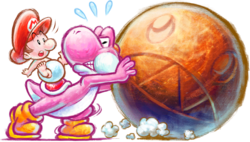 Yoshi's New Island artwork | |
| First appearance | Super Mario World 2: Yoshi's Island (1995) |
| Latest appearance | Poochy & Yoshi's Woolly World (2017) |
- “Don't forget—you can run over baddies with a Chomp Rock. Good things might happen!”
- —Message Block, Yoshi's New Island
Chomp Rocks, also known as Romp Chomps,[1] are round stones that look like Chain Chomp heads. They appear primarily in the Yoshi's Island series.
History[edit]
Yoshi's Island series[edit]
Chomp Rocks are common objects appearing in Super Mario World 2: Yoshi's Island and its Game Boy Advance versions. Chomp Rocks appear in gray and brown varieties, and the only difference is that gray ones will respawn at their starting point if the player goes offscreen and then returns, while the brown ones will not. Chomp Rocks are generally used for moving through soft rock and reaching high areas, but in some levels, they are an obstacle, such as when they need to be rolled off a thin pillar to reach a key. Some Sluggers hit these back and forth. Yoshi can push Chomp Rocks forward or jump on top of them to roll them in any direction. He can use Chomp Rocks to crush most enemies, including Tap-Tap. The Cave Of Chomp Rock is themed after them.
Chomp Rocks return in both sequels, Yoshi's Island DS and Yoshi's New Island. Though they are mostly the same as before, Chomp Rocks differ in Yoshi's Island DS in that neither color respawns, except for a brown one in the Island Museum's Land Enemy section. Chomp Rocks in Yoshi's New Island use the same model as snowballs, except the latter is retextured.[2]
Club Nintendo[edit]
In the Club Nintendo comic "Mario's Picross", Mario is arrested and locked up inside of a pyramid. He comes across a treasure chamber with a chest inside. When trying to pick up the treasure chest, a Chomp Rock is released through a trap door and starts rolling towards Mario. He escapes from the rock by jumping into a lorry and moving away.
Paper Mario series[edit]
Paper Mario[edit]
Chomp Rocks appear in Paper Mario as background objects in Dry Dry Ruins, and resemble the living Stone Chomps. They are also seen outside the Dry Dry Ruins, on decorative pedestals surrounding the outside. Paper Mario's Chomp Rocks have slightly gaping mouths.
Paper Mario: The Thousand-Year Door[edit]
Two Chomp Rocks appear in Paper Mario: The Thousand-Year Door in the Palace of Shadow Tower area, blocking the pipes that Mario needs to unlock the tower. Actual Chain-Chomps guard the pipes. In this incarnation, the rocks are hollow and have open mouths. Mario can destroy the rocks by throwing Admiral Bobbery into the gaping maws of the rocks. When Bobbery explodes, the rock is destroyed.
Mario & Luigi: Partners in Time[edit]
Brown Chomp Rocks appear in Mario & Luigi: Partners in Time, where the Yoshis are needed to move them on two occasions to open up new paths in Yoob's Belly. Five Yoshis can also use a Chomp Rock to lower Sunnycide's defense after the Bros. free them from Yoob eggs.
Yoshi's Woolly World[edit]
Chomp Rocks reappear in Yoshi's Woolly World, functioning identically as in the Yoshi's Island, though designed after amigurumi crochet spheres that come in many different color variations with white buttons for eyes. Frame Chomps can be turned into a Chomp Rock if Yoshi throws a yarn ball at one. The color of the Chomp Rock is determined by the color of yarn used.
Gallery[edit]
Yoshi pushing a red Chomp Rock
Names in other languages[edit]
| Language | Name | Meaning |
|---|---|---|
| Japanese | ワンワン岩[3] Wanwan Iwa |
Chain Chomp Rock |
| Chinese | 汪汪石 Wāngwāng Shí |
Chain Chomp Rock |
| Dutch | Chomp-steen |
Chomp Rock |
| French (NOA) | Roc Boulouf |
Chomp Rock |
| French (NOE) | Broie tout |
Crush everything |
| German | Big Chomp |
Big Chomp |
| Italian | Masso tritatutto |
Grinder Rock |
| Korean | 멍멍이돌 Meongmeong'i Dol |
Chain Chomp Rock |
| Portuguese | Pedra Dentada |
From pedra ("stone") and Corrente Dentada ("Chain Chomp") |
| Russian | Кусалковалун Kusalkovalun |
Chomp Boulder |
| Spanish | Roca Chomp |
Chomp Rock |
References[edit]
- ^ Black, Fletcher (2006). Yoshi's Island DS Prima Official Game Guide. Prima Games. ISBN 0-7615-5576-6. Page 16.
- ^ Image showcasing the retextured Chomp Rock.
- ^ (2002). 「スーパーマリオアドバンス3任天堂公式ガイドブック」 (Super Mario Advance 3 Nintendo Kōshiki Guidebook). Shogakukan (Japanese). ISBN 978-4091060716. Page 9.


